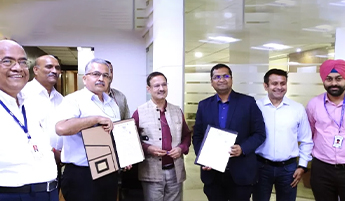India has emerged as a preferred destination for electronics manufacturing in recent years and for good reason. The country boasts a large and expanding consumer market, a strong IT industry, a skilled labor force, and government policies and initiatives that support the growth of the electronics manufacturing sector. In this blog, we will discuss the potential of the electronics manufacturing industry in India, the government’s initiatives to support the sector, and the global trends that favor India as a manufacturing hub.
Potential of Electronics Manufacturing in India
India has a rapidly growing consumer market for electronic products, driven by rising incomes, increasing urbanization, and growing adoption of digital technologies.
- Growth Prospect: According to the India Brand Equity Foundation (IBEF), the electronics manufacturing industry in India was valued at $75 billion in 2019-20 and is expected to reach $400 billion by 2025.
- Make in India: The government’s ‘Make in India’ initiative has attracted significant foreign direct investment (FDI) in the electronics manufacturing industry, with FDI in the electronics sector reaching USD 3.6 billion in 2022.
- IT Industry: India also has a large and an ever-growing pool of skilled labor, including engineers and technicians, which is essential for electronics manufacturing. The country’s strong IT industry can support the development of new technologies and the manufacturing of electronic products.
- Industrial Parks and Special Economic Zones (SEZs): The government has been investing in infrastructure development, including the development of industrial parks and special economic zones (SEZs) for electronics manufacturing. This provides companies with access to the necessary infrastructure and facilities for setting up, running, and expanding manufacturing operations in India.
These data points suggest that India has a strong potential for electronics manufacturing, driven by a growing domestic market, government support, and a skilled labor force.
Government Initiatives
The Indian government has implemented several policies and initiatives to support electronics manufacturing in the country. Here are some of the key policies and initiatives by the Govt. of India:
- Make in India: The ‘Make in India’ initiative, launched in 2014, offers financial incentives and tax breaks to companies that set up manufacturing operations in India.
- PLI Scheme: The Production Linked Incentive (PLI) scheme, which aims to promote domestic manufacturing of electronic products and components, has committed to providing incentives worth INR 40,951 crore ($5.5 billion) to large-scale electronics manufacturers over the next five years.
- Electronics Manufacturing Clusters (EMCs): The government has also established Electronics Manufacturing Clusters (EMCs) across the country, which offer infrastructure and facilities for electronics manufacturing.
- National Policy on Electronics (NPE): The National Policy on Electronics (NPE) aims to create an enabling environment for electronics manufacturing in the country. The policy sets a target of creating a $400 billion electronics manufacturing industry by 2025, with a focus on increasing domestic value addition and creating employment opportunities.
The above policies and initiatives have helped create a favorable business environment for electronics manufacturing in India, with financial incentives, streamlined regulations, and infrastructure support.
Global Trends and Scenarios
There are several global trends and developments that support the potential for electronics manufacturing in India.
- Geopolitical Stability: The geopolitical situation post-2020 has led to a shift in global supply chains, with India emerging as one of the preferred destinations for electronics manufacturing. India’s promotion as a manufacturing hub and implementation of policies to attract foreign investment have aided this shift.
- Strategic Location: India’s location provides easy access to major markets in Asia, Europe, and Africa via air and sea links, making it an ideal location for manufacturers looking to serve global markets.
- Favorable Business Environment: The Indian government has implemented initiatives to promote ease of doing business in the country, including measures to simplify regulations, reduce bureaucratic red tape, and attract foreign investment.
- Lower Labor Costs: Labor costs in other countries have been increasing in recent years, making it less competitive for electronics manufacturing. In contrast, India has a large pool of skilled labor that is available at a lower cost, making it an attractive destination for manufacturing operations.
- Strong Domestic Demand: The demand for electronics products is growing rapidly in India due to the adoption of digital technologies, increasing urbanization, and rising incomes. This provides strong domestic demand for electronics, making India an attractive destination for manufacturing operations.
- Technological Advancements: India has a strong IT industry and a growing pool of skilled labor, making it well-positioned to capitalize on emerging technologies such as the Internet of Things, artificial intelligence, and 5G. This can lead to the development of new electronics products and further strengthen India’s position as a hub for electronics manufacturing.
The above global trends and developments are expected to drive the growth of the electronics manufacturing industry in India in the coming years, making it an attractive destination for companies looking to diversify their manufacturing operations.
COVID -19 Disruption
The COVID-19 pandemic has brought about significant changes in the electronics manufacturing industry in India. The disruptions caused by the pandemic have led many companies to seek alternative manufacturing destinations, and India has emerged as an attractive destination for electronics manufacturing.
- Supply Chain Disruptions: The pandemic has disrupted global supply chains, leading to many companies exploring alternative manufacturing destinations. India’s large and growing consumer market, favorable business environment, and government support make it an attractive destination for electronics manufacturing. This has led to an increase in the number of companies setting up operations in India.
- Shift towards Remote Work and Digital Technologies: The pandemic has led to a shift towards remote work and digital technologies, driving the demand for electronic products such as laptops, smartphones, and other devices. India has a large and growing IT industry, making it well-positioned to develop and manufacture these products. This has further boosted the growth of the electronics manufacturing industry in India.
India has a bright future in electronics manufacturing, with a growing domestic market, government support, and a skilled labor force. The country’s policies and initiatives aim to create a favorable business environment for electronics manufacturing in India, with financial incentives, streamlined regulations, and infrastructure support. With the ongoing shift in global supply chains, India is well-positioned to become a manufacturing hub for electronic products.
VVDN Technologies: Leading the Way in Electronic Product Engineering and Manufacturing
VVDN Technologies is a global provider of engineering, manufacturing, digital services, and solutions, based in India, with a track record of successfully delivering electronic product engineering and manufacturing services to customers around the world. VVDN has established itself as a leading player in the industry.
One of the reasons for VVDN’s success is its ability to leverage government initiatives and the favorable business environment in India. As a company that has been approved under 4 PLI Schemes, VVDN is reaping the benefits of these initiatives, which have created a conducive environment for businesses to thrive. In addition, the changing geopolitical landscape has also worked in VVDN’s favor, as global companies look for reliable and cost-effective alternatives.
VVDN has an end-to-end setup for electronic manufacturing, which includes in-house best-in-class SMT Lines, Molding & Tooling Facility, Die Casting, Antenna Assembly, Sheet metal fabrication facility, Product Assembly Facility, and Product Certifications labs. This ensures that VVDN can deliver high-quality products to its customers efficiently and reliably. VVDN also has 11 advanced Product Engineering Centers in India and across the globe, which enables them to provide cutting-edge solutions to their customers. In addition to its product engineering capabilities, VVDN has 7 manufacturing facilities across India, which enables them to provide end-to-end manufacturing solutions to their customers.
Overall, VVDN Technologies has established itself as a leader in electronic product engineering and manufacturing. With its world-class facilities, skilled engineers, and a focus on delivering high-quality solutions to its customers, VVDN is well-positioned to continue its growth and success in the years to come.





















